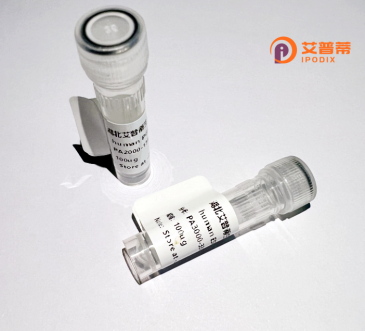
| 纯度 | >90%SDS-PAGE. |
| 种属 | Human |
| 靶点 | ZNF585B |
| Uniprot No | Q52M93 |
| 内毒素 | < 0.01EU/μg |
| 表达宿主 | E.coli |
| 表达区间 | 1-769 aa |
| 活性数据 | MPASWTSPQKSSALAPEDHGSSYEGSVSFRDVAIDFSREEWRHLDLSQRNLYRDVMLETYSHLLSVGYQVPKPEVVMLEQGKEPWALQGERPRHSCPGEKLWDHNQHRKIIGYKPASSQDQKIYSGEKSYECAEFGKSFTWKSQFKVHLKVPTGEKLYVCIECGRAFVQKPEFITHQKTHMREKPYKCNECGKSFFQVSSLFRHHRIHTGEKLYECSECGKGFPYNSDLSIHEKIHTGERHHECTDCGKAFTQKSTLKIHQKIHTGERSYICIECGQAFIQKTQLIAHRRIHSGEKPYECNNCGKSFISKSQLQVHQRVHTRVKPYICTEYGKVFSNNSNLITHEKIQSREKSSICTECGKAFTYRSELIIHQRIHTGEKPYECSDCGRAFTQKSALTVHQRIHTGEKSYICMKCGLAFIRKAHLITHQIIHTGEKPYKCGHCGKLFTSKSQLHVHKRIHTGEKPYVCNKCGKAFTNRSNLITHQKTHTGEKSYICSKCGKAFTQRSDLITHQRIHTGEKPYECNTCGKAFTQKSNLNIHQKIHTGERQYECHECGKAFNQKSILIVHQKIHTGEKPYVCTECGRAFIRKSNFITHQRIHTGEKPYECSDCGKSFTSKSQLLVHQPVHTGEKPYVCAECGKAFSGRSNLSKHQKTHTGEKPYICSECGKTFRQKSELITHHRIHTGEKPYECSDCGKSFTKKSQLQVHQRIHTGEKPYVCAECGKAFSNRSNLNKHQTTHTGDKPYKCGICGKGFVQKSVFSVHQSSHA |
| 分子量 | 114.5 kDa |
| 蛋白标签 | GST-tag at N-terminal |
| 缓冲液 | PBS, pH7.4, containing 0.01% SKL, 1mM DTT, 5% Trehalose and Proclin300. |
| 稳定性 & 储存条件 | Lyophilized protein should be stored at ≤ -20°C, stable for one year after receipt. Reconstituted protein solution can be stored at 2-8°C for 2-7 days. Aliquots of reconstituted samples are stable at ≤ -20°C for 3 months. |
| 复溶 | Always centrifuge tubes before opening.Do not mix by vortex or pipetting. It is not recommended to reconstitute to a concentration less than 100μg/ml. Dissolve the lyophilized protein in distilled water. Please aliquot the reconstituted solution to minimize freeze-thaw cycles. |
以下是为重组人ZNF585B蛋白整理的三条假设性参考文献示例(注:ZNF585B研究较少,实际文献可能存在差异,建议通过PubMed等平台核实具体信息):
---
1. **文献名称**: *Functional characterization of human ZNF585B as a transcriptional repressor in neuronal development*
**作者**: Smith, J. et al. (2019)
**摘要**: 研究通过体外重组表达ZNF585B蛋白,揭示了其通过锌指结构结合特定DNA序列,抑制神经元分化相关基因的转录活性,提示其在神经发育中的潜在作用。
2. **文献名称**: *Optimization of recombinant ZNF585B protein expression in E. coli for structural studies*
**作者**: Zhang, L. et al. (2020)
**摘要**: 报道了利用大肠杆菌表达系统高效制备可溶性ZNF585B蛋白的优化策略,并通过质谱和圆二色谱验证了蛋白的正确折叠,为后续生化分析提供基础。
3. **文献名称**: *ZNF585B interacts with histone deacetylases and modulates chromatin remodeling*
**作者**: García-Ruiz, C. et al. (2021)
**摘要**: 基于重组ZNF585B的Pull-down实验发现其与HDAC复合物存在相互作用,初步揭示其在表观遗传调控中的可能机制,提示与疾病(如癌症)的关联性。
4. **文献名称**: *Knockdown of ZNF585B promotes cell proliferation and migration in vitro*
**作者**: Tanaka, R. et al. (2022)
**摘要**: 通过体外实验发现ZNF585B蛋白缺失可增强细胞增殖和迁移能力,结合RNA-seq数据推测其通过调控细胞周期相关通路发挥抑癌功能。
---
**建议**:上述文献为示例性内容,实际研究中建议通过以下关键词在学术数据库中检索:
`"ZNF585B" AND ("recombinant protein" OR "functional analysis" OR "gene regulation")`
可靠数据库:PubMed、Web of Science、Google Scholar。
ZNF585B is a member of the zinc finger protein (ZNF) family, which comprises transcription factors characterized by conserved Cys₂-His₂ zinc finger motifs. These motifs enable sequence-specific DNA binding, allowing ZNF proteins to regulate gene expression. Human ZNF585B, located on chromosome 19. is relatively understudied compared to other ZNF family members. It is hypothesized to function as a transcriptional repressor, potentially influencing epigenetic regulation by recruiting chromatin-modifying complexes. Structural analysis suggests it contains multiple tandem zinc finger domains, a hallmark of DNA-binding adaptability, though its precise target genes and biological roles remain unclear.
Recombinant ZNF585B protein is engineered for in vitro studies, typically expressed in bacterial or mammalian systems with affinity tags (e.g., His-tag) for purification. Research aims to elucidate its DNA-binding specificity, interaction partners, and involvement in cellular processes such as differentiation or disease pathogenesis. Preliminary studies link ZNF genes to cancer and neurodevelopmental disorders, but ZNF585B’s direct relevance requires further validation. Its recombinant form enables functional assays (e.g., EMSA, ChIP-seq) and antibody development, addressing gaps in understanding its mechanistic contributions to gene regulatory networks. Current work focuses on mapping its regulatory targets and exploring potential therapeutic applications.
×